Abstract
Environmental education from pre-school age is becoming one of the most urgent issues all over the world including Russia. Preschool age is a valuable stage in the development of human environmental culture. At this age, the foundations of the personality are laid, including a positive attitude towards nature and the world around. It is at this age, when it is possible to form ecological knowledge, norms and rules of interaction with nature, to develop empathy for it, and to be active in solving some environmental problems. The aim of the research is the theoretical study and experimental verification of the content, forms and methods of the effective ecological education of preschool children. T.A. Serebryakova’s methodology was used for the diagnosis of the ecological knowledge level. This technique helps determining the level of skills to care for nature objects. Based on the results of ascertaining measurement a program of preschool children’s ecological education was implemented. After using different forms and methods of ecological education including games, exercises, excursions, and joint activities, we measured the level of preschoolers’ environmental awareness again. The results demonstrated the change in preschool children’s level of environmental awareness. There were no children with low levels; significant direct connections intensified. The carried out statistical processing of data substantiated that the changes were not accidental. The results of the case-study allowed making methodological recommendations for the further development of environmental education of preschool children children.
Keywords: Ecological educationpreschoolforms and methods
Introduction
Even 20-30 years ago, environmental issues were discussed mainly by the specialists and biologists, but now the term is firmly entrenched in many of our lives, whether we are specialists or not. Even children know that you cannot spoil the "environmental ecology". ‘Ecology’, ‘the environmental situation’, ‘the ecological crises’, - words and phrases such as these we hear more and more often. According to the results of sociological researches ( Ermakov & Petrov, 2004; Laptev, 2008; Novozhilova, 2008; Khapay, 2009), the term "ecology" is one of the most popular and commonly used words in the world. This is no accident. Scientific and technological progress improves the human conditions of life, improves its quality. However, growing human intervention, causing environmental changes can lead to irreversible consequences in an environmental and biological sense. Mankind raises the question of the conservation of the biological species of Homo sapiens as a result of such violations of the ecological balance in the biosphere.
The outcomes of the World Summit on Sustainable Development emphasize that the most important mechanism to ensure sustainable development is education. The United Nations has declared the period 2005-2014 the Decade of Education for Sustainable Development.
Particular attention is paid in education to ecological issues, and many relevant programs have been published. However, in most cases, ecological education is focused on the factual knowledge and doesn’t promote environmental awareness, ecological culture and disposition. Therefore, most people in Russia are well aware of what pollution is, and how it affects human health and the state of nature, but even this knowledge does not appear to become a real incentive for their environmentally purposeful behaviour.
In order to be effective, ecological education and training today must address this main problem: to form an environmentally oriented consciousness and behaviour, essentially a new vision of the world. Currently, this is the dominant view of the natural world, which awards man the highest value and sees nature as his property, the attitude towards nature is to see it as an object of influence, conversion and use.
Problem Statement
The problem of the formation of an ecologically focused consciousness and behaviour can be defined as an educational problem. According to many scientists ( Gaysin, 2002; Mironov, 1989; Nikolaeva, 2011; Parfilova, 2003; Zakhlebnyi, 1986; Zverev, 1996), ecological education should be an organic and integral part of the overall upbringing and education process.
Ecologically oriented consciousness and behaviour emphasize unity of man and nature. The development of man and nature is understood as a co-evolution. Organizing diagnostic measures for ecological education in kindergarten, you must remember that if the children's knowledge about the natural world is easy enough to identify, their attitude is quite difficult to identify. Attitude is a personal characteristic, and we cannot know only by means of organizing any form of environmental work with children, what is their real attitude to the natural world
Analysis of educational research has shown that the issues of ecological education have long occupied an important place in the Russian scientific researches.
The problem of organizing a system of continuous ecological education and training has been considered by Alekseev ( 1984), Glazachev ( 1997), Yagodyn & Tretyakova ( 1990).
Important contributions to the development of ecological education and of ecological culture problems in modern educational theory were made by Zakhlebnyi ( 1986), Zverev ( 1996), Gaysin ( 2002), Mironov ( 1989), Reimers ( 1990), Shilov ( 2001), Suravegina ( 1988). They justified principles, goals, objectives, forms of organization and methods of ecological education, developed the basis of its content, made recommendations on the formation of ecological knowledge and skills of behaviour in nature and defined the conditions for the realization of ecological education ideas.
Ideas of familiarizing preschool children with nature have been further developed in the theory and practice of the Soviet, and later Russian pre-school education in the articles, scientific and methodological papers ( Volkova, 1952; Zalkind, 1947; Ryzhova, 2001; Kalatskaya, 2013; Parfilova, 2003; Parfilova & Kalimullin, 2014). For a long time, a great help to practitioners of pre-school education were manuals by Lucic ( 1989), and recommendations by Sizenko ( 1966). Generations of teachers had learned from the Veretennikova’s (1973) textbook. An important role for teachers and trainers emphasized the importance of focusing on observation as the main method of familiarization with the environment, leading to the accumulation, refinement and expansion of reliable information about nature ( Mazurina, 1976; Nizova & Monich, 1966).
Nevertheless, while paying tribute to the named researches, revealing the essence, forms and methods of ecological education, it should be noted that the issues of ecological education of preschool children are still not sufficiently studied.
Research Questions
What is the level of environmental awareness of preschool children before the experiment? What are the content, forms and methods of the preschool children’s ecological education? What is the level of environmental awareness of preschool children after the implementation of the experimental program of preschool children’s ecological education?
Purpose of the Study
The purpose of this paper is the theoretical study and experimental verification of the content, forms and methods of the preschool children’s ecological education.
Research Methods
Theoretical and empirical methods
In compliance with the purposes, the following methods were selected:
theoretical: analysis of psychological and pedagogical, ecological and methodical literature, comparison, generalization);
empirical: ascertaining, formative and controlling experiment.
Statistical analysis of empirical research was conducted using a standard method of mathematical statistics – t-Student’s criterion.
For the diagnosis of ecological education, we chose a technique ( Serebryakova, 2008) for determining the level of children’s skills to care for natural objects. This technique also helped identifying the nature of the child’s relationship to the natural world.
The following were the control tasks for determining the preschoolers’ ecological knowledge level.
Task 1. Determination of the animal world representatives characteristics (conducted individually with each child). Objective: To determine the level of knowledge of the animal world representatives characteristics.
Task 2. Determination of the characteristic features of the plant world (conducted individually with each child). Objective: To determine the level of knowledge of the plant world characteristics.
Task 3: Determination of the characteristic features of inanimate nature (conducted individually with each child). Objective: To determine the level of knowledge of the inanimate nature characteristics.
Task 4. Knowledge of seasons (conducted individually or in small subgroups). Objective: To determine the level of the seasons knowledge.
The following targets helped determining the level of skills to care for natural objects.
Task 1. Determine which plants are suitable for this model. Objective: To identify the degree of formation of skills relating to how to care for plants, the ability to establish dependence of methods of plant care from its form and structure.
Task 2. Help the animal. Objective: To identify the knowledge and skills to care for the inhabitants of the corner of nature (fish, birds).
Task 3. Collect the seeds for a "bird's dining room." Objective: To identify the level of skills to collect seeds for the birds.
The methodology aimed at identifying the characteristics of the relationship to the natural world includes three game problems the children had to solve.
The trial design and stages of the research
The empirical study was conducted in the kindergarten in the city of Kazan. The study involved 20 children aged 6-7 years.
During the examination rooms were sufficiently lit, they were away from the noisy parts of the building.
The first (ascertaining) stage of the experiment was aimed at determining the initial values of ecological education. On this basis, a program including a variety of forms and methods of preschool children’s ecological education was developed.
On the next, formative stage, the active work on implementing this program was organized.
Then, on the controlling phase of our experiment, we evaluated the effectiveness of the forms and methods of preschool children’s ecological education. At this stage, we found indicators of preschool children’s ecological education and studied their dynamics.
Evaluation criteria
We allocated the following types of criteria in the structure of ecological education: cognitive abilities; the attitude towards nature; and, work skills. We investigated these in the course of the experimental work.
The criterion of cognitive abilities:
Children’s cognitive skills accordance with their age characteristics and capacities;
The degree of autonomy in using cognitive skills.
The criterion of the attitude towards nature:
Children's continuous interest in the natural world;
The need to penetrate the essence of the phenomena and processes that occur in nature;
The ability to emotionally react to objects, phenomena of the natural environment;
Manifestation of humane feelings when interacting with nature;
The criterion of work skills:
The quality and productivity of work in nature;
The degree of independence of children in work.
Based on the research we identified three levels of preschool children’s ecological education: H - high, M- medium, L - low.
H- The child chooses independently the ways of caring for plants, names the largest number of offered representatives of the plant world, wild and domestic animals, pinpoints their group, determines the distinctive features, and accurately performs labor operations. The child shows a stable interest in a work identifies the basic connections and consistent patterns and actively expresses her/his emotions.
M – The child self-calls representatives of flora and fauna, but admits the error in determining the signs; with the help of an adult s/he sets dependencies. Her/his interest in the work is unstable; s/he does not always notice the basic relationships and dependencies. S/he notes minor details, making conclusions on an adult’s suggestive questions.
L - The child is hampered in determining groups of plants, calls some species with the help of an adult. S/he has difficulty in establishing dependencies, shows no desire to participate in work; s/he does not solve the task of an adult and shows negative attitude to the objects of nature.
Findings
In the diagnosis of the level of ecological knowledge formation we obtained the following results: a high level of knowledge about the animal world and the seasons amounted to 20% each, the knowledge of the plant world and the knowledge of inanimate nature - 15%. The medium level of knowledge about the animal world - 55%, of the plant world - 60%, knowledge of inanimate nature and the seasons - by 70%. The low level of knowledge about the flora and fauna amounted to 25%, of inanimate nature - 10%, and the seasons- 5% (Table
The diagnostic results of skills to care for objects of nature formation gave us the following results for the first assignment: 15% of preschool children had a high level, the medium level - 70%, and the low level -15%. According to the second task the high level amounted to only 20%, medium - 75%, and a low level - 5%. After the third task we obtained the following results: high and low levels were only 10%, medium - 80% (Table
As a result of techniques aimed at identifying the characteristics of the relationship to the natural world, we found that only 17% of the children had a high level of relationship to the natural world, a low level - 58%, medium - 25% (Table
When considering all three components the medium level dominates, which is knowledge - 66%, the attitudes - 58%, the activity - 75%. The high level of knowledge-component is 17.5%, of attitudes-component -17%, and the activity-component is15%. The low level of knowledge demonstrated 16.5% of children, of attitudes - 25% and of activities - 10%. (Table
According to the results of ascertaining experiment, preschoolers have the following average amount of the general ecological education level: 17.2% of children have a low level, 56.3% - the medium and 16.5% - a high level (Figure
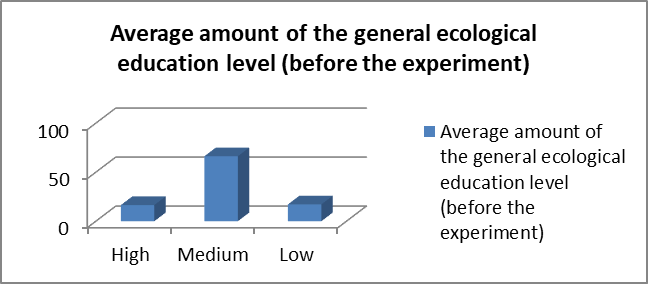
According to the data, we see that the percentage of indicators on the scales is variable. However, the observed trend is that in all cases the proportion of children at the medium level is half of the entire set of data. If we compare the percentage ratio of the high and medium levels, we can see that the number of subjects at the medium level is almost three times the number of subjects at the high level. With regard to the scale of the intensity ratio, which is an integral indicator, high and low values are close to a certain extent, and medium values are just over half of the aggregate of all values. The presence of low levels may indicate that the ecological education within this preschool is implemented inadequately.
All the results obtained at the at the first stage were analyzed and according to this analysis, the program of preschool children ecological education was then developed, and implemented in the formative stage of the experiment.
The purpose of the formative stage of the experiment was thus to improve the preschool children’s ecological education using of various forms and methods of educative work.
The tasks for this phase were defined as:
To acquaint children with the system of concepts and ideas related to the environment.
To establish a system of beliefs, values and attitudes that encourages learning of new ecological knowledge and implementing them in their work and in their attitude to reality.
To form a high level of activity among the children, not only in participating, but also in organizing the ecological activities.
Based on psychological and pedagogical knowledge of preschool children’s age specifics and the social situation of their development, we have taken the following forms and methods of ecological education: conversation, games of environmental content, exercises, stories, instructions, riddles about nature and animals, guided tours and the method of joint activities.
It is possible to create conditions for the development of the ecological education, ecological culture, and ecological consciousness of children only in the situation of student-centered teacher interaction with children. This kind of teacher follows in her/his interaction with children the principle of respect for the personality of each child. S/he always calls children by name, talks individually to each child as often as possible. When talking s/he tries to stay at the same level as the child (e.g. sits on a low chair). S/he listens kindly to children, answering questions, discussing problems, and s/he does not disregard their requests. This provides each child the opportunity to say what s/he is interested in, why he is happy or sad. The teacher accepts the ideas and suggestions of children in the organization of general activities, games, in the planning of activities and thanks them for their help.
In the controlling stage, the same operations as in the initial stage were organized. After a series of formative stages we got differing results.
The level of knowledge about the natural world after the experiment was as follows: knowledge of the animal world had the highest average level - 50%. The knowledge of flora and of inanimate nature amounted to 30% of high level and 70% - medium. Knowledge of the seasons on a high level was 70%, and of medium level - 30% (Figure
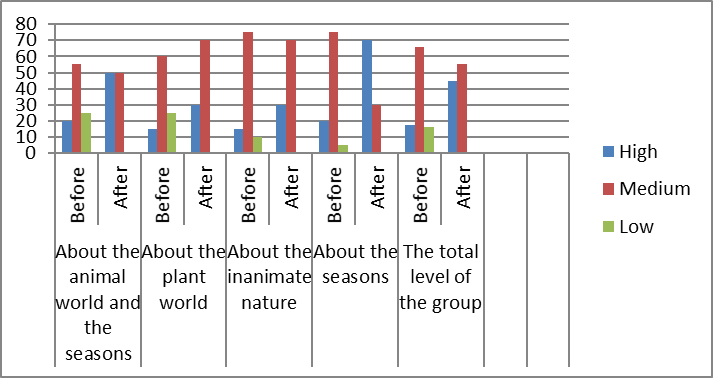
According to the results of diagnostics on identifying the character of the relationship to the natural world we obtained the following results for the first task: a high level - 100%. Task two: a high level - 95% of the children, an medium - only 5%. The third task was a high level - 80%, and the medium was 20%.
For the results of the study of the skills to care for objects of nature level after the experiment, we obtained the following: the first and the second task 90% of children showed a high level, and the medium was only 10%/ The results of the third task were even higher: a high level - 95% , medium - 5%. There was no low level in all three tasks (Figure
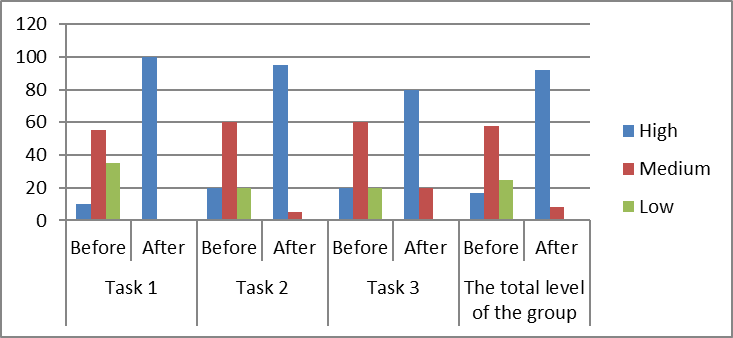
When considering the level of ecological education of preschool children by components, then we see that the activity and attitude component have the same high level - 92%, while the cognitive component has 45% of a high level and 55% of medium level (Figure
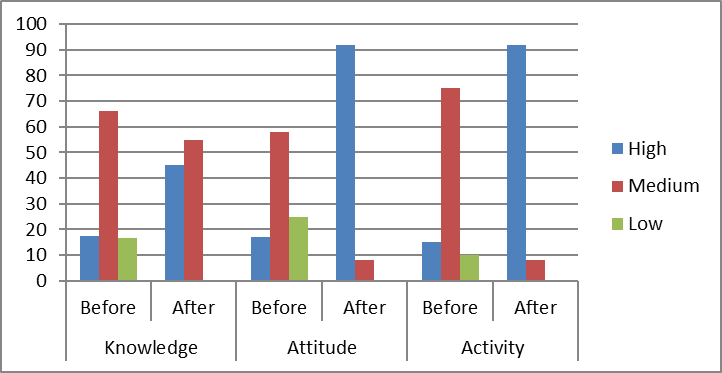
The overall level of ecological education of children has a very good indicator: 76% on a high level, 24% on the medium, and there is no low level (Figure
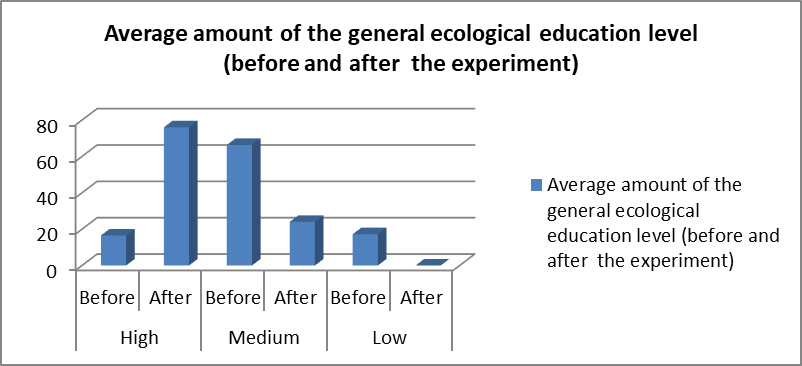
After the experiment the children’s attitude to nature changed too. This can testify to the aesthetic development of children, their responsiveness to the vital displays; the desire to receive, to seek, to process information about objects of the nature and to change their environment according to their subjective attitude to nature.
The data led to the conclusion that the level of pupils’ ecological education after formative work changed. This finding led to the conclusion about the effectiveness of the work on preschool children’s ecological education.
To test the significance of differences in the data obtained before and after the implementation of the developed program statistical comparison of the average by Student’s t-test was carried out.
Originally hypotheses H0 and H1 were formulated:
H0: significant differences between formative and ascertaining experiment were not found.
H1: significant differences between formative and ascertaining experiment were found. If | temp |> tcr, then we reject the null hypothesis and accept the alternative, that is, separately consider reliable mean difference. If temp <tcr, the mean difference is unreliable.
To calculate this criterion it is necessary to count the number of degrees of freedom (ν) for n = 20. This number is 19. For ν = 19 in special tables, we find the critical values of the t-test. According to the interested in confidence level of 99%, these differences are considered valid. By substituting all the values in the formula of the Student’s t-test, we found that in temp in the tasks aimed at determining the level of knowledge about the natural world = 11.88. In the tasks aimed at determining the level of skills to care for nature objects temp = 14.48. The tasks aimed at identifying the nature of the attitude to the natural world temp = 11.88. Therefore, we reject the null hypothesis and accept the alternative, i.e the values obtained in the experimental group before the experiment differ from the values obtained after.
Conclusion
The main objective of ecological education is the formation of the personal qualities, as a result of the process and outcome of environmental education of the person and implies the indissoluble unity between the knowledge, ideas about the nature, emotional and value attitudes and relevant skills, experience, needs of interaction with it, based on the harmonization of the relationships in the system "man-nature".
Based on psychological and pedagogical knowledge of the specifics of the preschool age children, we have identified the following features of their ecological education:
Ecological education of children should be based on the knowledge and skills that pre-school children have, mainly manifested in the game - the leading activity of preschool children;
Visual-arts activities, like the game, allow for deeper understanding of the topics the children are interested in;
The integral part of ecological education in this period is the perception of fairy-tales;
The joint activities of adult and child, aimed at solving cognitive tasks in everyday life, play, work, i.e. in the process of understanding the world are also important.
Acknowledgments
The work is performed according to the Russian Government Program of Competitive Growth of Kazan Federal University.
References
- Alekseev, A. I. (1984). Moral education of high school students in environmental activities. Moscow: Akademia.
- Ermakov, D. S., & Petrov, Y. P. (2004). Ecological education: the opinion of experts and schoolchildren. Sotsis, 9, 64-67.
- Gaysin, I. T. (2002). The continuity of environmental education. Kazan: Publishing house "Tang".
- Glazachev, S. N. (1997). Ecological culture, education and civilizational choice of Russia. Nauka i Shkola, 3, 4 -11.
- Kalatskaya, N. N. (2013). Psychological profile of primary school children learning according to different educational technologies. In Recent trends in Social and Behaviour Sciences. In 2nd International Congress on Interdisciplinary Behaviour and Social Sciences. Jakarta, Indonesia.
- Khapay, N. A. (2009). Ecological Culture of the Youth of Modern Russia: Sociological Analysis. Maikop: Adyghe State University.
- Laptev, I. D. (2008). Ecological problems of our time. Moscow: Mysl.
- Lucic, M. (1989). Children of Nature. Moscow: Prosvetshenie.
- Mazurina, A. F. (1976). Observations and children’s work in nature. Moscow: Prosvetshenie.
- Mironov, A. V. (1989). The aesthetic and moral development in the ecological education of schoolchildren. Kazan: Tatknigoizdat.
- Nikolaeva, S. N. (2011). The system of preschool children ecological education. Moscow: MOSAIKA-SINTEZ.
- Nizova, A. M., & Monich, A. A. (1966). The lessons of natural history in the first class. Moscow: Academy of pedagogical sciences of the RSFSR.
- Novozhilova, E. O. (2008). Sociology of global ecological processes. Sotsis, 9, 59-67.
- Parfilova, G. G., & Kalimullin, A. M. (2014). Research of Russian Students’ Ecological Competency. Social and Behavioral Sciences, 131, 35-39.
- Parfilova, G. G. (2003). Ecological education of primary school children in the family. Kazan: KSPU.
- Reimers, N. F. (1990). Nature Management. Dictionary. Moscow: Mysl.
- Ryzhova, N. A. (2001). Ecological education in kindergarten. Moscow: Karapuz.
- Serebryakova, T. A. (2008). Ecological education at the preschool age. Moscow: Publishing center "Academy".
- Shilov, M. N. (2001). About family ecological education and the need to correct behaviours. Ecology and culture. Krasnoyarsk: Akademia.
- Sizenko, Z. D. (1966). Nature and children. Moscow: Prosvetshenie.
- Suravegina, I. T. (1988). On the methods of the schoolchildren responsible attitude towards nature formation. Biology at School, 3, 32-40.
- Veretennikova, S. A. (1973). Introducing nature to preschoolers. Moscow: Prosvetshenie.
- Volkova, E. I. (1952). Pre-school education in the years of Stalin's five-year plans. Moscow: Gosuchpedgiz.
- Yagodyn, G. A., & Tretyakova, L. G. (1990). The problem of ecological education. Education in the field of environment. Kazan: Tatknigoizdat.
- Zakhlebnyi, A. N. (1986). The content of ecological education in the secondary school. Moscow: Prosvescsheniye.
- Zalkind, E. I. (1947). Nature in kindergarten. Moscow: Uchpedgiz.
- Zverev, I. D. (1996). Ecological education and training: key issues. Volgograd: Peremena.
Copyright information

This work is licensed under a Creative Commons Attribution-NonCommercial-NoDerivatives 4.0 International License.
About this article
Publication Date
23 January 2020
Article Doi
eBook ISBN
978-1-80296-077-8
Publisher
European Publisher
Volume
78
Print ISBN (optional)
-
Edition Number
1st Edition
Pages
1-838
Subjects
Teacher, teacher training, teaching skills, teaching techniques
Cite this article as:
Valeeva*, R. A., & Parfilova, G. G. (2020). Ensuring Effective Formation Of Children’s Ecological Education In Russian Preschool. In R. Valeeva (Ed.), Teacher Education- IFTE 2019, vol 78. European Proceedings of Social and Behavioural Sciences (pp. 775-786). European Publisher. https://doi.org/10.15405/epsbs.2020.01.84
